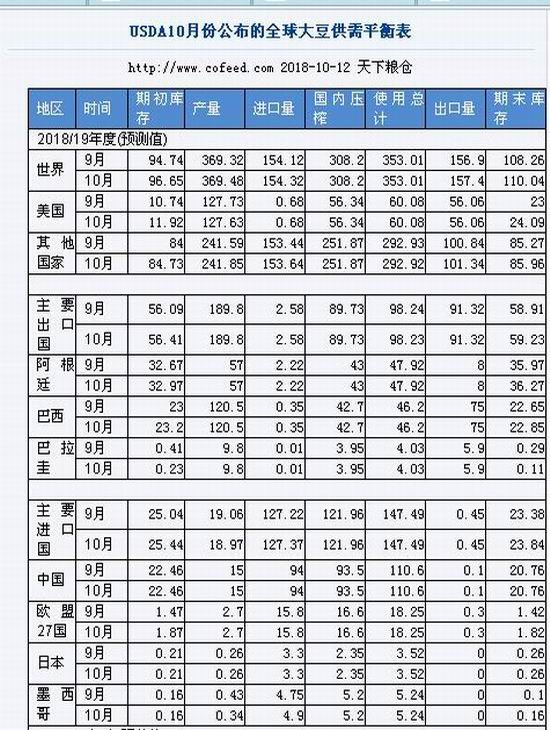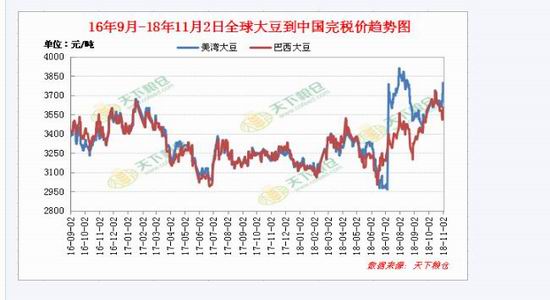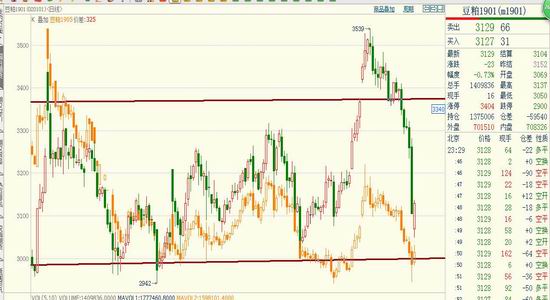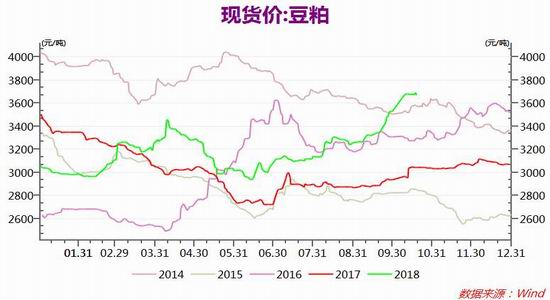Due to the ever-changing strategies of options, this paper judges the time, direction and range of the market. Considering that the 1901 option contract is close to delivery, the Theta value of the Greek alphabet will decline faster, while the Delta value and Gamma value will also fluctuate faster. In order to avoid the impact of the two, we adopt the 1905 far month option contract hedging, that is, calendar arbitrage strategy. At the same time, it is worth dynamically tracking through Greece to conduct risk management.
Fundamental supply and demand analysis:
Short term global soybean The trade pattern is premised on the evolution of Sino US relations:
On November 1, President Xi Jinping made an ordinary telephone call with President Trand of the United States at request. Trump said that I attach importance to the good relationship with President Xi Jinping and would like to extend good wishes to the Chinese people through President Xi Jinping. It is very important for the two heads of state to have frequent direct communication, and we should maintain regular contact. I look forward to meeting again with President Xi Jinping during the G20 Summit in Argentina. We can have in-depth discussions on some major issues. It is hoped that both sides will work together to make full preparations for our meeting. The US side attaches importance to US China economic and trade cooperation and is willing to continue to expand exports to China. It is necessary for the economic teams of the two countries to strengthen communication and consultation. I support American enterprises to actively participate in the first China International Import Expo. Earlier, despite the overwhelming opposition at home and abroad, the U.S. government announced that it would impose 10% tariffs on China's products imported to the United States from about $200 billion as of September 24, and would take other tariff escalation measures. Some economic policy advisers at the White House believe that tariffs have "hurt" China's economy and that continuing to upgrade tariffs will put more pressure on China's economy. This wishful thinking seriously underestimates the strength and resilience of China's economy, and completely ignores the economic situation in the United States and the aspirations of some people. After China imposed a 25% tariff on US $34 billion worth of imports from the United States, including soybeans, in July, soybean imports attracted much attention. The tariff measure is a retaliatory action against the imposition of tariffs by the United States on Chinese goods of equal value imported from the United States.
Xinhua Finance: Four insiders said that US President Donald Trump hopes to reach an agreement with China on trade issues at the G20 Summit in Argentina at the end of November, and has asked key US officials to start drafting possible terms. Trump has asked senior officials to let their staff draft a potential agreement to send a signal of easing in the escalating trade friction. People familiar with the matter also said that many institutions had participated in the drafting of the agreement.
According to the data released by the General Administration of Customs of China, the number of Brazilian soybeans purchased in September jumped by 28% compared with the same period last year, and buyers hoarded stocks before the expected shortage in supply in the fourth quarter. This is the first time since March this year that China has provided data on the source of bulk commodity imports. Chinese buyers imported 7.59 million tons of Brazilian soybeans in September, up from 5.94 million tons in the same period last year. Brazil accounted for 95% of the 8010000 tons of soybeans imported by China in September, up from 73% in the same period last year. According to Cofeed's real-time survey statistics, the actual arrival of 99 ships of soybeans imported from domestic ports in October was 6.205 million tons, slightly lower than the previously predicted 6.399 million tons, mainly because three ships of soybeans were delayed. The actual arrivals in October decreased by 8.6% compared with 678.92 last October. In November, 90 ships of 5.742 million tons of imported soybeans are expected to arrive at domestic ports. It is estimated that 6 million tons of soybeans will arrive at the port in December, 5.3 million tons in January, and only 3 million tons in February. However, Chinese buyers are still looking for soybeans, and Brazilian and Argentine oil refineries are also reselling soybeans for shipment in December. The arrival of soybeans in February will continue to rise.
According to the Russian satellite news agency, thousands of tons of non GMO soybeans planted by Chinese enterprises in the Russian Far East have been transported to the Chinese market from the Russian port of Khabarovsk on October 18, which also means that high-quality soybeans produced in Russia may further expand the market share.
China has lowered the protein content standard in feed formula, which is expected to affect tens of millions of tons Soybean meal At the same time, the large price difference between soybean meal and miscellaneous meal also affected the demand for soybean meal. African swine fever has broken out frequently. Up to now, there have been 54 cases of African swine fever in the market. More than 200000 pigs have been slaughtered accumulatively. Breeders are also cautious in making up the list, which affects the terminal demand of soybean meal. Recently, the consumption of soybean meal has been sluggish, with an average daily turnover of only 80000 tons, and the soybean meal inventory has increased accordingly. As of the week of October 26, the total stock of soybean meal of oil factories in major coastal areas of China was 893600 tons, 123400 tons more than 770200 tons last week, an increase of 16.02%, and 34.55% more than 664100 tons in the same period last year.
This year's sowing is earlier and the sowing speed is the fastest in history. Brazil's new beans can be shipped at the end of December at the earliest. It is estimated that 3 million tons of soybeans can be shipped in January. As well as the poor crushing profit in South America, the Brazilian and Argentine crushing plants continued to resell soybeans to Chinese oil plants. In recent two weeks, oil plants have successively bought about 17 ships from December to January. At present, there are many ships of soybeans in December on sale. In addition, it is rumored that if the supply is tight, the Reserve will sell some soybeans in January and February next year. Long term soybean supply gap is far smaller than expected. Oil producers' confidence in price fixing has weakened significantly.
From the perspective of global supply, the monthly supply and demand report of the US Department of Agriculture in October predicted that the unit yield of US soybeans could reach 53.1 bushels, and the output could reach 4.69 billion bushels. The high yield of US soybeans increased the global soybean supply. This year's US soybean production may set a record, and global soybean supply is loose in the fourth quarter. Looking at domestic supply, due to the impact of the Sino US trade war in the early stage, China did not import American soybeans, which led to the reduction of China's soybean phased imports and better crushing profits. At present, the atmosphere of Sino US trade war has only eased, and there is still much uncertainty about whether reconciliation can be reached later. The mid-term elections in the United States on November 6 are an important time node.
In general, CBOT soybeans and Dalian soymeal are obviously differentiated due to the impact of the trade war, and the dominant factors are inconsistent. American soybeans are in high yield but lose Chinese buyers and keep falling. China imports South American soybeans at high prices due to its own demand. The phased shortage of supply and rising costs are important factors to support the price in the period. At the same time, Sino US trade and swine fever also have a greater impact on them, And Sino US trade frictions and national policies are the dominant factors.
Figure 1: Global soybean supply and demand table
Data source: Tianxia Granary
Figure 2: China's soybean supply and demand table
Data source: Tianxia Granary
Figure 3: Crushing profit
Data source: Tianxia Granary
Figure 4: Soybean landed cost
Data source: Tianxia Granary
Technical analysis:
Figure 5: Technical drawings of 1901 and 1905
Data source: POBO
Figure 6: Price Difference between 1901 and 1905
Data source: POBO
We can see that at present, the price difference between 1901 and 1905 of soybean meal fluctuates greatly, which is mainly affected by Sino US trade frictions, with a fluctuation range of 250-500 in the last two months.
Seasonal analysis:
The price of soybean meal fluctuates seasonally, which is mainly affected by the price of imported soybeans and weather factors. For the time interval of the transaction: before January, American soybeans were mainly imported, and the stock was concentrated before the year, with strong prices. After January, South America's early maturing soybeans had no worries about harvest supply; In China, due to holiday factors such as New Year's Day and Spring Festival, the overall stocking pace of end feed manufacturers will slow down, and the price of soybean meal will fluctuate. In the whole price trend, the prices at the beginning of the year are usually higher than those in March. In April, affected by the weather in South America, soybeans entered the weather market. At the same time, the demand side gradually expanded and the price gradually went out of decline.
Figure 7: Seasonal trend
Data source: Wind, Hualian Futures Database
Greek Value Analysis
Figure 8: Greek value analysis (time points 11-7-9:00)
Data source: Wenhua Finance
Figure 9: Greek value analysis (time points 11-7-9:00)
Data source: Wenhua Finance
Because the price of soybean meal is seasonal and the price has seasonal difference, from the price difference between the 1901 contract and the 1905 contract, the price difference has recently fluctuated sharply around the center of the price difference at 300 points. Therefore, it is necessary to change the horizontal arbitrage strategy and use different execution prices to achieve strategic effect.
By analyzing the Greek value of the 1901 contract and the 1905 contract, the strategy basically hedges the risks of Delta and Gamma (for example, selling M1901-C-3250; buying M1905-C-2900, its static T=- (1.22-0.34)=-0.88; D=-0.345+0.386=0.041), Keep the Theta value, enjoy the time value, and the volatility of slightly false value in recent months (20.7%) is higher than that in far months (18.1%), which is more favorable for short volatility. At the same time, because the put option and call option hedging expose different positive and negative delta values, their values are small and can be ignored. If the hedging position is large, the exposed directional position (Dlata value) can be hedged by buying or selling futures M1901 contract. In short, the direction, time and volatility are well managed through the management of Greek letters.
Figure 10: Recent Volatility
Data source: Wind, Hualian Futures Database
Figure 11: Theta acceleration
Data source: Wind, Hualian Futures Database
Price deduction: sell M1901-C-3250; For example, buy M1905-C-2900100 for horizontal arbitrage. The current Greek value is as follows:
Figure 12: Greek value dynamics
Data source: Hualian Futures Database
Of course, other levels of arbitrage can also carry out dynamic risk management similar to the Greek alphabet.
Timeline event analysis:
The United States Congress will hold mid-term elections on Tuesday, November 6. The results of the elections determine the ownership of congressional control and have an impact on future policy trends. Especially the Sino US trade policy and its impact on soybeans.
On November 8 (Thursday), the latest round of monthly supply and demand report of USDA and USDA will be released soon, and the report data may affect the market of USDA and soybean meal.
Option strategy
The trading method of calendar (horizontal) arbitrage is to buy an option and sell an option with the same strike price, the same call or put category, but different maturity dates.
Because forward options and short-term options have different decay rates of time value. In general, the time value of short-term options declines faster than that of forward options. Therefore, the general practice of horizontal arbitrage is to buy forward options and sell short-term options. Horizontal arbitrage includes call option horizontal arbitrage and put option horizontal arbitrage.
Because the price of soybean meal is seasonal and the price has seasonal difference, from the price difference between the 1901 contract and the 1905 contract, the price difference has recently fluctuated sharply around the center of the price difference at 300 points. Therefore, it is necessary to change the horizontal arbitrage strategy and use different execution prices to achieve strategic effect. The contract time value (THETA) of soybean meal 1901 in recent months will accelerate with the passage of time, while the soybean meal 1905 corresponding to the production cycle in South America will decline slowly due to its long time, but the Sino US trade policy and logistics and weather in South America will interfere with the panel price difference.
Specific strategy: Since there are more than 20 days before the expiration of the 1901 contractual options, the arrangement is ahead of schedule. The soybean meal 1901 contract and the soybean meal 1905 contract have seasonal differences. We have made a corresponding adjustment to the strike price in the level spread arbitrage. The strike price is selected according to the slight false value option, combining the range and time point analysis, so we decided to sell the false value put option in the recent month (soybean meal 1901) and buy the false value put option in the far month (soybean meal 1905). Or sell the dummy call option of the recent month (soybean meal 1901) and buy the dummy call option of the far month (soybean meal 1805), so as to earn the relative value of the accelerated recession of the recent contract. Specific contract: You can sell the virtual value of the shallow degree of the recent contract (M1901-C-3200 or M1901-P-3100; M1901-C-3250 or M1901-P-3050;), At the same time, buy the far month shallow dummy option (M1905-C-2850 or M1905-P-2700; M1905-C-2900 or M1905-P-2750). The total position of this strategy is controlled at 50% (5 million).
Risk control:
At present, the price difference of soybean meal in the near and far months is around 300. If the price difference fluctuates greatly, the effect of the strategy will be discounted. Therefore, attention should be paid to the price difference between the two. If the price difference is favorable, the position will be held. If the price difference has adverse effects, the position size should be reduced. In short, the total loss should be controlled within 500000 yuan.
Hualian Futures and Options Team
Sina statement: The purpose of posting this article on Sina.com is to convey more information, which does not mean to agree with its views or confirm its description. The content of this article is for reference only and does not constitute investment advice. Investors operate accordingly at their own risk.
Editor in charge: Song Peng

























